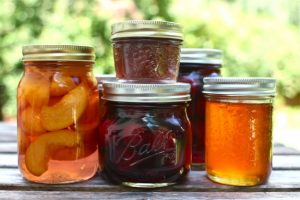Illinois farms gain new options to sell foods directly
By Kay Shipman FarmWeek — February 6, 2022
Changes covered under the Home to Market Act make it easier for those who make food or drinks in their home kitchen, or an appropriate kitchen located on the farm, to sell directly to consumers.
The new year opened new markets and options for Illinois farmers and food entrepreneurs to sell their homemade products directly to consumers.
The changes make it easier for those who make food or drinks in their home kitchen, or an appropriate kitchen located on the farm, to sell directly to consumers. The Home to Market Act rules took effect Jan. 1 and were signed into law by Gov. J.B. Pritzker last year.
“There are way more avenues than there were in 2021,” said Mary Liz Wright, a University of Illinois Extension nutrition and wellness educator. Wright discussed the rules during the Illinois Specialty Crop Conference in January.
Previously limited to selling at farmers markets, farms and home bakers may now sell at fairs, festivals and pop-up events, according to Wright. They may also sell non-perishable products online directly to consumers within Illinois. Out-of-state online sales are prohibited.
Wright emphasized a direct-to-consumer focus underscores the law’s underlying principle of product traceability back to its origins. She explained that is why the rules do not allow sales to restaurants, grocery stores or distributors that would sell to customers.
What homemade foods and drinks can be sold? Wright said the rules specify which ones are prohibited.
Prohibited foods and drinks include:
- Meat, poultry, dairy and eggs, except dairy and eggs used as ingredients in nonhazardous baked goods
- Garlic in oil or oil infused with garlic
- Low-acidic foods, such as soups, vegetables or food combinations
- Wild, harvested mushrooms
- Alcoholic beverages and kombucha.
Wright explained home cooks may acidify low-acid foods they plan to sell. A list of acidified or fermented foods would include tomatoes, pickles, sauerkraut and chilled coleslaw. For example, an acidified tomato recipe would include a tablespoon of bottled lemon juice or two tablespoons of vinegar or one-fourth teaspoon of citric acid.
“We encourage people follow a tested USDA or Cooperative Extension recipe,” Wright added.
Home to Market Act rules specify home-canned foods for sale must be done in a proper, safe manner with boiling water, a vacuum-sealed mason jar with a two-piece lid. Jars must be sterilized in boiling water for 10 minutes.
State-approved canning methods for low-acidic foods are a boiling water bath or pressure canning. “This is to kill potential deadly bacterium,” Wright noted.
The new rules also expanded sale opportunities for frozen and chilled foods and drinks. Chilled products must be kept at a temperature of at least 41 degrees Fahrenheit. Wright suggested that could be accomplished with dry ice or chunks of ice. Frozen foods must be maintained at a temperature of 32 degrees or lower.
The new rules update state labeling requirements to ensure important information is included for consumers and that the labels are prominent on packages and at the point of sale.
Wright emphasized each label must provide the required information. “This is essential and what health departments will look for,” she said.
A label must include the seller’s name, county of operation, the product’s common food name, the processing date and the seller’s health department registration number.
Every label must also include the following language: “This product was produced in a home kitchen not subject to public health inspection that may also process common food allergens. If you have safety concerns, contact your local health department.”
Labels must list all ingredients, including any food coloring, artificial flavors and preservatives. Those must be listed in descending order by weight as common names. In addition, allergen information, such as milk, eggs or wheat, should be included as specified in federal labeling requirements.
Wright explained posting label information on a placard at the point of sale as well as a product label. For online sales, the information needs to be posted online in a spot where consumers will see the product.
Potential customers may sample the product under the new rules. Wright explained two options for offering samples. Prepare and pre-package samples at home and bring them to the site. Samples may be made on-site, but the seller needs to first get a certificate from the local health department and meet sanitation requirements.
This story was distributed through a cooperative project between Illinois Farm Bureau and the Illinois Press Association. For more food and farming news, visit FarmWeekNow.com.







